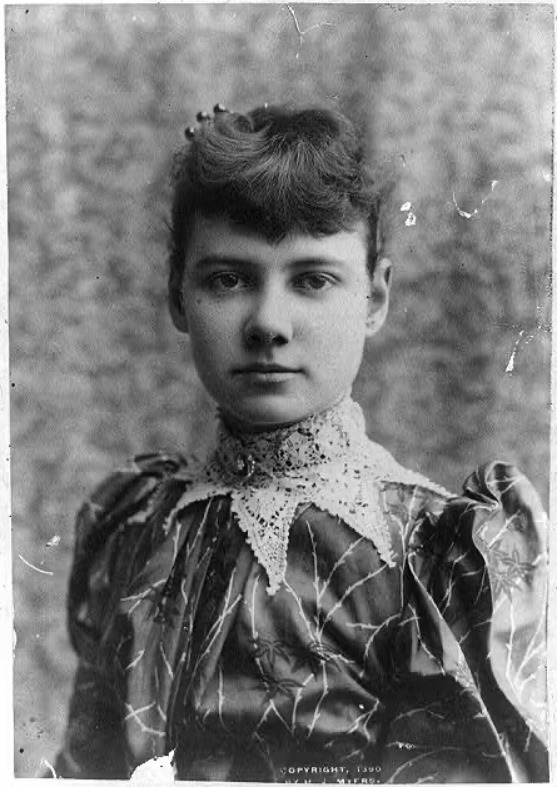Nellie Bly: Fearless Pursuer of Truth – Bold and Unstoppable!

How far would you go to uncover the truth? In 1887, a young female reporter checked herself into a notorious New York asylum and shocked the world with her findings. She was Nellie Bly. Her groundbreaking work inspired a new era of investigative journalism. She is also known for her record-breaking trip around the Globe. An inspirational figure she was far ahead of her times.
Nellie Bly was a pioneer journalist, inventor, industrialist, and philanthropist. She used her pen like a sword and used unusual methods to investigate. Her Fearlessness earned her a place in history.
She was born Elizabeth Jane Cochran on 5th May 1864 in Cochran’s Mills Pennsylvania. Bly’s father founded the town and earned money for the family from being both a judge and owning land. Unfortunately, when Elizabeth was 6 her father died and to make matters worse he died without leaving a will. This tragic event ended up leaving the family without financial support. This, in turn, led to Elizabeth dropping out of school due to being unable to pay the fee and the remaining family moving to Pittsburgh to run a boarding house. One day in 1885, Elizabeth was reading The Pittsburgh Dispatch. An article titled ‘What Girls Are Good For’ lambasted women who wanted education or a career. Elizabeth wrote a scathing letter to the Dispatch and signed it ‘Lonely Orphan Girl’. The editor liked Elizabeth’s arguments so much that he made her a reporter for the Dispatch. She wrote under the name Nellie Bly.
Bly was initially focused on issues primarily affecting women such as the need for reformed divorce laws to general injustices in society. She wrote about the poor conditions of workers in Pittsburgh factories. Her columns rattled some feathers and she was promptly shifted to women’s lifestyle pages.
Bored with the change, she decided to be a foreign correspondent and spent six months in Mexico, writing about workers’ everyday lives. Her stint was cut short after she criticized the President of Mexico. She eventually left Despatch and went to New York City for some exciting work. Nellie joined the New York World. One of her first assignments for the paper was to uncover the truth about the rumors that surrounded the Blackwell mental asylum facility. She was asked to report things as it is. In 1887, Bly checked herself into The lunatic asylum. For 10 days, she witnessed the horrors of the asylum from the overcrowded and filthy surroundings to spoiled food, scanty clothes, and unhygienic baths as well as abusive and neglected treatment by staff including severe beating and relentless verbal assault.
Upon her release, Bly shared her experience in a series of articles published in the New York World, which were later compiled in a book called ‘Ten Days in Madhouse’. The published articles provoked controversy prompting public outrage and calling for reforms. Her reporting also contributed to the larger issue of mistreating mentally ill patients leading to the formation of a committee to look at the mental health facilities.
Her method of finding the truth was groundbreaking. It proved to be a landmark in investigative journalism. Her determination and singlemindedness in uncovering the truth led to the much-needed social change. Her exposure at the lunatic asylum started a new form of reporting called stunt reporting or investigative journalism.
Now that Bly was famous, she began to seek another big story. Having read Jules Verne’s fictional tale ‘Around the World in 80 Days’, Bly became interested in finding out if this was possible in the restricted time frame She decided to take the trip alone to find out. She set out in November 1889 on her trip with little luggage and the backing of The New York World.
The journey was very eventful. She started her trip in Hoboken, New Jersey in Nov. 1889, traveling by ship, horse, rickshaw, burro, and other vehicles. During her journey, New York World ran a daily contest asking readers to guess Bly’s location and nearly one million people participated, which was a huge success for both Bly and the paper. She completed the trip in seventy-two days, six hours, eleven minutes, and 14 seconds She achieved all this success and attention at the age of only twenty-five years.
Nellie Bly got married at the age of thirty to a millionaire who was forty years her senior. They had a happy but short marriage. Bly took over after her husband’s death. She brought many changes to the factory like health benefits to workers, improving the work conditions, etc. She also patented the products made by the company. However, her inexperience in managing things led to the bankruptcy of the firm. She then went back to her first love- journalism.
The women’s suffrage movement was in full swing and Bly wrote about the marches and calls for vote. In the latter half of 1910, she covered the W.W.I. and became the first woman war correspondent in the United States. She got her column in the New York Journal in 1919 but could not continue because of her failing health. At the age of fifty-seven, Nellie Bly died because of pneumonia.
In 1998 Bly was inducted into the National Women’s Hall of Fame and in 2002 she was honoured by the US Postal Service with a stamp in set ‘Women in Journalism’. In 2021, ‘The Girl Puzzle’ by Amanda Matthews, a memorial art of Nellie Bly was unveiled to the world, where her first undercover story started at Roosevelt Island.
Nellie Bly took the road less traveled. Her journalism often led her to sweatshops, lobbyists, conferences, legislature, and even jails. She became the best-known woman journalist of her time by tackling such issues. She removed the label that was set upon women that they were only good for cooking, cleaning, and caring for Children. She became an inspiration to women around the world. She is the face of female resilience. Even today, A star woman reporter is called ‘Nellie Bly’.
Bly’s pioneering work not only shattered the gender norms of her time but also laid the groundwork for future generations of journalists. Her dedication to shedding light on the hidden corners of society, particularly in advocating for mental health reform, demonstrated the power of journalism as a force for positive change.
In the annals of literature and journalism, Nellie Bly stands as a symbol of courage, tenacity, and the unwavering pursuit of truth. Her legacy continues to inspire journalists and writers to this day, reminding us of the transformative impact that storytelling and investigative reporting can have on society. As we reflect on her contributions, it is clear that Nellie Bly’s legacy extends beyond the printed page; it is a testament to the enduring power of journalism to challenge, provoke thought, and drive social progress.
–Nidhi Raj is an independent writing professional, storyteller, and mother with a keen interest in women’s issues and International Relations.








